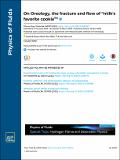On Oreology, the fracture and flow of “milk's favorite cookie ® ”
Author(s)
Owens, Crystal E; Fan, Max R; Hart, A John; McKinley, Gareth H
DownloadPublished version (7.940Mb)
Publisher with Creative Commons License
Publisher with Creative Commons License
Creative Commons Attribution
Terms of use
Metadata
Show full item recordAbstract
<jats:p> The mechanical experience of consumption (i.e., feel, softness, and texture) of many foods is intrinsic to their enjoyable consumption, one example being the habit of twisting a sandwich cookie to reveal the cream. Scientifically, sandwich cookies present a paradigmatic model of parallel plate rheometry in which a fluid sample, the cream, is held between two parallel plates, the wafers. When the wafers are counter-rotated, the cream deforms, flows, and ultimately fractures, leading to separation of the cookie into two pieces. We introduce Oreology (/ɔriːˈɒlədʒi/), from the Nabisco Oreo for “cookie” and the Greek rheo logia for “flow study,” as the study of the flow and fracture of sandwich cookies. Using a laboratory rheometer, we measure failure mechanics of the eponymous Oreo's “creme” and probe the influence of rotation rate, amount of creme, and flavor on the stress–strain curve and postmortem creme distribution. The results typically show adhesive failure, in which nearly all (95%) creme remains on one wafer after failure, and we ascribe this to the production process, as we confirm that the creme-heavy side is uniformly oriented within most of the boxes of Oreos. However, cookies in boxes stored under potentially adverse conditions (higher temperature and humidity) show cohesive failure resulting in the creme dividing between wafer halves after failure. Failure mechanics further classify the creme texture as “mushy.” Finally, we introduce and validate the design of an open-source, three-dimensionally printed Oreometer powered by rubber bands and coins for encouraging higher precision home studies to contribute new discoveries to this incipient field of study. </jats:p>
Date issued
2022Department
Massachusetts Institute of Technology. Department of Mechanical EngineeringJournal
Physics of Fluids
Publisher
AIP Publishing
Citation
Owens, Crystal E, Fan, Max R, Hart, A John and McKinley, Gareth H. 2022. "On Oreology, the fracture and flow of “milk's favorite cookie ® ”." Physics of Fluids, 34 (4).
Version: Final published version